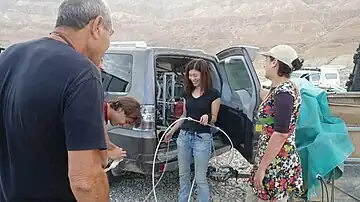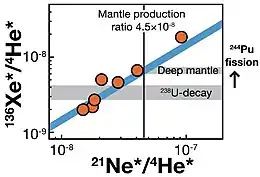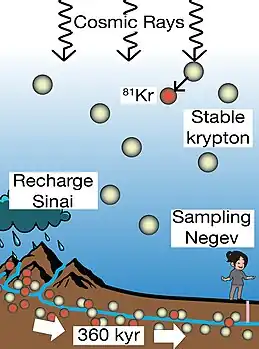
Reika Yokochi (横地玲果, born November 9, 1975 in Saga, Kyushu Prefecture, Japan) is a Japanese geochemist working on the origin and geological behavior of volatile elements. She currently holds the position of Research Professor in the Department of the Geophysical Sciences at the University of Chicago.[1] Yokochi leads a laboratory specializing in the purification and analysis of noble gases for dating and tracing water circulation within Earth's crust.[1][2]
Education and early career
Yokochi completed her doctoral studies in earth sciences at National Polytechnic Institute of Lorraine (French: L'Institut National Polytechnique de Lorraine) in 2005, supervised by Bernard Marty. Her PhD thesis focused on understanding the origin of volatile elements in Earth. She identified the presence of noble gases of solar origin in Earth's deep mantle. She also worked out the contribution of 244Pu-decay (t1/2=81 Myr) to fissiogenic 136Xe* in the deep Earth, suggesting a protracted loss of volatiles from Earth's mantle.[3] Between 2005 and 2008, she was a postdoctoral researcher with Neil C. Sturchio at the University of Illinois Chicago, after which she joined the University of Chicago as researcher in 2008.[1]

Research activities
Yokochi's research focuses on noble gas geochemistry. She uses noble gases radionuclides, notably Krypton-81 (81Kr; t1/2=230,000 yr),[5] to study the age and circulation of groundwater in major aquifers worldwide, including the Nubian Sandstone Aquifer,[6][7] Floridan Aquifer,[8] and the geothermal waters of Yellowstone.[9] Krypton-81 is produced by cosmic rays in the atmosphere and then dissolves into rainwater, eventually seeping into groundwater. The overall abundance of krypton in the atmosphere is only about 1.10 parts per million by volume (ppmv), and within this, the fraction of 81Kr is extremely small, about 5 × 10−13. Yokochi crafted a device capable of efficiently extracting krypton from vast quantities of groundwater, thus facilitating the accurate quantification of 81Kr using Atom Trap Trace Analysis (ATTA). [10]

In a study of the Nubian Sandstone Aquifer in Israel's Negev Desert, Yokochi and colleagues utilized radiokrypton (81Kr) to date groundwater, discovering two major water recharge events.[11] The first, about 38,000 years ago, originated from the Mediterranean, and the second, around 361,000 years ago, from the tropical Atlantic. These events, coinciding with periods of low orbital eccentricity, reveal the sensitivity of moisture transport to orbital forcing. The study highlights groundwater's potential as a record of ancient precipitation and long-term subsurface water storage.
Application of 81Kr to the Floridan Aquifer revealed freshwater recharge from the Last Glacial Period.[8] Additionally, it detected fossil seawater predating the Last Glacial Maximum, indicating slow seawater movement and a limited but significant exchange of solutes with the ocean, contributing to the aquifer's dolomitization.
Yokochi also conducted experiments aimed at understanding how volatile elements are trapped in ices under conditions relevant to the formation of comets and icy moons.[12][13] The results of those experiments showed that ice surfaces have heterogeneous adsorption energies, influenced by initial ice-deposition temperatures and thermal annealing. Adsorption sites with higher energy play a significant role at low pressures and higher temperatures, conditions relevant to the protosolar nebula. The experiments also showed that gas trapping occurs primarily through the burial of gas adsorbed on newly formed ice surfaces. Yokochi's experiments indicate that the formation temperature of comet 67P/Churyumov-Gerasimenko, as suggested by the observed Ar/H2O ratio, was around 40 K.
Yokochi contributed to the analysis of gases in samples returned from the Ryugu asteroid by JAXA's Hayabusa2 mission.[14][15]
Awards and recognition
Yokochi received the Young Scientist Award from the Geochemistry Research Association of Japan in 2012; the same year, she was also named a NASA Planetary Science Early Career Fellow.[16]
Personal life
Reika Yokochi is married to Nicolas Dauphas, a fellow planetary scientist; the couple has two children.
References
- 1 2 3 "Reika Yokochi". Department of the Geological Sciences, University of Chicago. Archived from the original on 2023-07-14. Retrieved 2023-12-25.
- ↑ "Reika Yokochi". Google Scholar. Retrieved 2023-12-25.
- ↑ Yokochi, Reika (2005-01-01). L' azote, le néon et le xénon dans le manteau : sources, processus et hétérogénéités (PhD thesis thesis) (in French). National Polytechnic Institute of Lorraine. Archived from the original on 2021-02-07. Retrieved 2023-12-25.
- ↑ Yokochi, Reika; Marty, Bernard (2005). "Geochemical constraints on mantle dynamics in the Hadean". Earth and Planetary Science Letters. 238 (1–2): 17–30. doi:10.1016/j.epsl.2005.07.020. ISSN 0012-821X.
- ↑ Lu, Z.-T.; Schlosser, P.; Smethie, W.M.; Sturchio, N.C.; Fischer, T.P.; Kennedy, B.M.; Purtschert, R.; Severinghaus, J.P.; Solomon, D.K.; Tanhua, T.; Yokochi, R. (2014). "Tracer applications of noble gas radionuclides in the geosciences". Earth-Science Reviews. 138: 196–214. arXiv:1305.4608. Bibcode:2014ESRv..138..196L. doi:10.1016/j.earscirev.2013.09.002.
- 1 2 Spizzirri, John; Lerner, Louise (2019-07-29). "Krypton reveals ancient water beneath the Israeli desert". University of Chicago News. Archived from the original on 2023-07-02. Retrieved 2023-12-25.
- ↑ Strongin, Ronni (2019-07-30). "Krypton Reveals Ancient Water Beneath the Negev". Americans for Ben-Gurion University. Retrieved 2023-12-25.
- 1 2 Mitchem, Savannah (2021-09-30). "Scientists use nuclear physics to probe Floridan Aquifer threatened by climate change". Argonne National Laboratory. Archived from the original on 2023-02-09. Retrieved 2023-12-25.
- ↑ Yokochi, R.; Sturchio, N. C.; Purtschert, R.; Jiang, W.; Lu, Z. -T.; Mueller, P.; Yang, G. -M.; Kennedy, B. M.; Kharaka, Y. (2013-02-15). "Noble gas radionuclides in Yellowstone geothermal gas emissions: A reconnaissance". Chemical Geology. Frontiers in Gas Geochemistry. 339: 43–51. Bibcode:2013ChGeo.339...43Y. doi:10.1016/j.chemgeo.2012.09.037. ISSN 0009-2541.
- ↑ Yokochi, Reika; Heraty, Linnea J.; Sturchio, Neil C. (2008). "Method for Purification of Krypton from Environmental Samples for Analysis of Radiokrypton Isotopes". Analytical Chemistry. 80 (22): 8688–8693. doi:10.1021/ac801804x. PMID 18947236.
- ↑ Yokochi, R.; Ram, R.; Zappala, J.C.; Jiang, W.; Adar, E.; Bernier, R.; Burg, A.; Dayan, U.; Lu, Z.T.; Mueller, P.; Purtschert, R. (2019). "Radiokrypton unveils dual moisture sources of a deep desert aquifer". Proceedings of the National Academy of Sciences. 116 (33): 16222–16227. Bibcode:2019PNAS..11616222Y. doi:10.1073/pnas.1904260116. PMC 6697870. PMID 31358637.
- ↑ Yokochi, Reika; Marboeuf, Ulysse; Quirico, Eric; Schmitt, Bernard (2012). "Pressure dependent trace gas trapping in amorphous water ice at 77K: Implications for determining conditions of comet formation". Icarus. 218 (2): 760–770. Bibcode:2012Icar..218..760Y. doi:10.1016/j.icarus.2012.02.003. ISSN 0019-1035.
- ↑ Yokochi, Reika (2022). "Adsorption-driven Gas Trapping in Cometary Ice Analogs". The Astrophysical Journal. American Astronomical Society. 940 (2): 153. Bibcode:2022ApJ...940..153Y. doi:10.3847/1538-4357/ac9621.
- ↑ Lerner, Louise (2022-06-09). "Scientists release first analysis of rocks plucked from speeding asteroid". University of Chicago News. Archived from the original on 2023-07-02. Retrieved 2023-12-25.
- ↑ Okazaki, Ryuji; Marty, Bernard; Busemann, Henner; Hashizume, Ko; Gilmour, Jamie D.; Meshik, Alex; Yada, Toru; Kitajima, Fumio; Broadley, Michael W.; Byrne, David; Füri, Evelyn; Riebe, My E. I.; Krietsch, Daniela; Maden, Colin; Ishida, Akizumi (2023-02-24). "Noble gases and nitrogen in samples of asteroid Ryugu record its volatile sources and recent surface evolution". Science. 379 (6634): eabo0431. Bibcode:2023Sci...379.0431O. doi:10.1126/science.abo0431. ISSN 0036-8075. PMID 36264828. S2CID 253045328. Archived from the original on 2023-05-21. Retrieved 2023-12-25.
- ↑ "Reika Yokochi". University of Chicago. Archived from the original on 2022-04-18. Retrieved 2023-12-25.